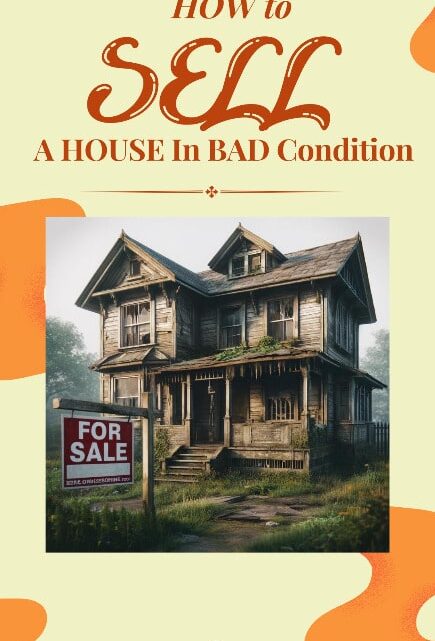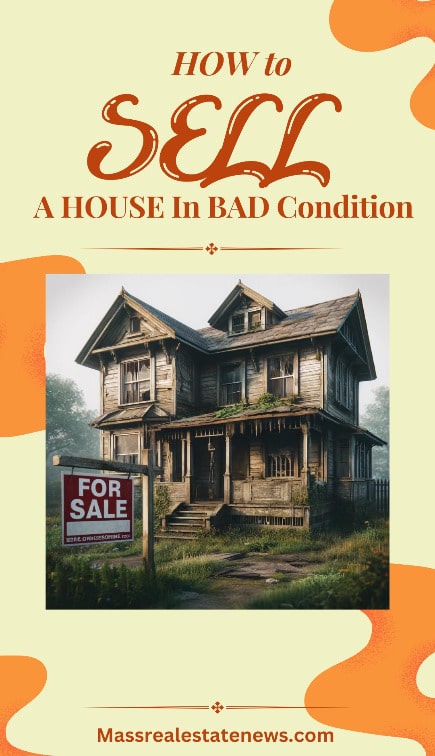Selling a house in poor condition in Massachusetts can be challenging. Whether dealing with structural issues or outdated interiors, homeowners must carefully weigh their options.
Navigating the sale of a property that isn’t in prime shape requires understanding the best strategies for repairing or selling it as is, weighing the financial implications, and making intelligent decisions to maximize returns.
I will provide you with tips and guidance on the following:
- Practical strategies for making your property appealing even in less-than-ideal states.
- The benefits and drawbacks of investing in repairs versus opting for an “as is” sale.
- Key considerations to estimate the financial impact and potential return on investments for renovations.
From being a Massachusetts Realtor for the past three decades, I know the challenges of selling a home as-is. Homes that are in rough shape are usually harder to sell and therefore stay on the market longer. The buyer pool shrinks for homes that are not turnkey. However, there are things you can do to make the selling process more successful.
Let’s review the best approaches to turn your challenging sale into a profitable endeavor.
The Challenges of Selling a Massachusetts Home in Bad Condition
Selling a home in less-than-ideal condition can be daunting. These homes often have various issues, from cosmetic flaws to severe structural problems. Understanding these challenges is the first step to having a successful sale.
Houses in poor condition typically attract fewer buyers. Many potential homeowners are looking for turnkey properties—homes they can move into without making substantial repairs. This is especially true with today’s generation of home buyers.
A property’s visual appeal and first impression significantly impact buyer interest, and a house showing signs of neglect often fares poorly in these areas.
Moreover, severe issues like foundational cracks, roof damage, or outdated electrical systems can scare off buyers who fear the costs and efforts of fixing significant defects. These problems decrease the home’s market value and limit the pool of interested buyers.
Sellers are often left with those specializing in renovations or seeking a significantly lower purchase price. For example, companies like We Buy Ugly Houses that purchase homes as-is for cash.
By fully grasping these challenges, homeowners can more effectively strategize how to present their property to the market. Deciding whether repairs or selling “as is” offers the best chance of success becomes paramount.
It is crucial to understand that you will lose money selling as-is.
Strategies for Selling a Property in Poor Condition
Selling a house in lousy condition requires a thoughtful approach to attract the right buyers and secure a reasonable sale price.
Here are effective strategies to consider:
1. Selling ‘As Is’: Selling the house “as is” can be straightforward. This means selling the home in its current state without making any repairs. It’s a clear signal to buyers that the asking price reflects the home’s condition, and they are responsible for future maintenance. This method can attract investors and flippers seeking a project or bargain hunters seeking a lower price point.
2. Targeting the Right Buyers: Identifying the ideal buyer demographic is crucial. Investors, property flippers, and those looking for a fixer-upper are typically the most interested in houses that need work. Again, think of real estate investors like We Buy Ugly Houses. Marketing efforts should be tailored to appeal to buyers who see potential where others see problems.
3. Effective Marketing: Even a house in poor condition has potential advantages. Focus on these in your marketing materials. Highlight features like good bones, a desirable location, or a large lot size. Utilize professional photography that strategically showcases the property’s best angles while being honest about its flaws. Follow the best home-selling tips.
4. Transparency: Being upfront about the property’s condition can build trust with potential buyers and help prevent surprises during the buying process. Providing a pre-sale inspection report is one way to demonstrate transparency, giving buyers a detailed understanding of what to expect and the scope of repairs needed.
When executed well, these strategies can help mitigate the drawbacks of selling a house in poor condition and even turn them into selling points.
Pros and Cons of Repairing vs. Selling “As Is”
Deciding whether to repair your house before selling or to sell it “as is” is a crucial choice that can significantly affect the sale outcome. Here’s a breakdown of the advantages and disadvantages of each option:
Repairing the House Pros
- Increased Market Value: Making necessary repairs can significantly boost the home’s value and attract more buyers.
- Faster Sale: A move-in-ready home is more appealing to most buyers, potentially leading to a quicker sale.
- Higher Offers: Buyers are often willing to pay more for a home that doesn’t require immediate repairs.
Repairing The House Cons
- Upfront Costs: Repairs can be expensive, and once renovations start, there’s always the risk of uncovering more problems. Avoiding things you shouldn’t fix is also essential.
- Time-Consuming: The repair process can be lengthy, delaying the listing and sale of the property.
- Uncertain ROI: Not all repairs will offer a return on investment, especially if market conditions change or you over-improve the neighborhood. An excellent real estate agent can help you avoid low-ROI investments.
Selling ‘As Is’ Pros
- Quick Sale Process: Selling “as is” allows you to list the property more quickly without waiting for repairs to be completed.
- No Repair Hassles: You avoid the stress and unpredictability of the repair process.
- Attracts Specific Buyers: Investors and flippers often look for “as is” properties they can renovate themselves.
Selling ‘As Is’ Cons
- Lower Sale Price: From years of experience, homes sold “as is” often fetch lower prices due to the repairs and upgrades the buyer will need to assume.
- Limited Buyer Pool: You might limit your market to those looking specifically for fixer-uppers or investment properties.
- Negotiation Challenges: Buyers might use the “as is” condition to drive the price down even further, especially after inspections.
Real-Life Example
I recently had a client in Milford, Massachusetts, who chose to repair their home before the sale. The initial cost of repairs was $20,000, but it increased the home’s value by $50,000 and attracted multiple offers above the asking price.
In contrast, another homeowner in the same neighborhood sold their property “as is” and received offers that were $25,000 less than similar-sized homes in better condition. This shows how money in the right places can significantly impact the selling process.
Financial Considerations and ROI Estimation
When deciding whether to invest in repairs before selling your house or to sell it “as is,” understanding the financial implications is crucial.
Here’s how to approach estimating the return on investment (ROI) for any repairs and assess whether the investment is likely to pay off:
1. Estimating Costs: Start by getting multiple estimates from contractors for the necessary repairs. This will give you a clearer picture of the upfront costs involved. Add a contingency budget for unexpected expenses, which is typical in repair projects.
2. Research Market Values: Compare the potential market value of your home post-repairs to its current “as is” value. This comparative market analysis should factor in recent sales of similar homes in your area, both renovated and unrenovated. Real estate agents and online real estate platforms can provide insight into these figures.
3. Calculate Potential ROI: The ROI can be calculated by subtracting the total cost of the repairs from the expected increase in sale price and then dividing that number by the cost of the repairs. Multiply the result by 100 to get a percentage. For example, if repairs cost $20,000 and increase the home’s value by $30,000, the ROI would be 50%.
4. Consider Time and Effort: Your decision should also consider the time and effort required to manage repairs. Even if the financial ROI seems favorable, the personal time commitment might not be worth it, especially if you need to sell quickly.
5. Evaluate Financing Options: If upfront cash for repairs is an issue, explore financing options such as a home equity line of credit or a personal loan. However, this will add to the total cost due to interest payments, which must be factored into your ROI calculations.
6. Consider Tax Implications: Speak with a tax advisor about any potential tax implications of selling your home after making significant repairs. For example, some improvements might qualify for tax deductions, which can further affect your net gain.
Real-Life Example
Based on my advice, a Hopkinton, Massachusetts, homeowner spent $15,000 on kitchen and bathroom updates. These improvements helped the house sell for $25,000 more than similar properties in “as is” condition, netting a simple ROI of 66.67%, not accounting for additional selling costs or taxes.
Step-by-Step Guide to Selling a Massachusetts House in Lousy Condition
Selling a house in poor condition involves a series of strategic steps to ensure you maximize your sale potential. Here is a comprehensive step-by-step guide:
1. Get a Pre-Sale Inspection
Start with a thorough inspection to understand what needs repair. This inspection can help you decide whether to sell “as is” or make repairs. It also provides transparency and builds trust with potential buyers, who will appreciate knowing what issues they might face.
2. Choose the Right Real Estate Agent
Select an agent experienced in selling homes in terrible conditions or fixer-uppers. Their expertise in this market can be invaluable for pricing your home correctly and marketing it to the right audience.
3. Set a Realistic Price
Price your home based on its current condition and the local market. Overpricing a fixer-upper can deter potential buyers, while underpricing can mean leaving money on the table. Your real estate agent can provide a comparative market analysis to help set a competitive price.
Chad Thibodeaux of RE/MAX Horseshoe Bay offers this advice when selling a home that needs some help:
“When listing a home that is in less-than-ideal condition, it’s important to price it correctly, which means factoring in the cost of necessary repairs. A home’s price should reflect its current state, including any renovations or updates it may need.
By correctly assessing and then subtracting these repair costs from the potential market value of a similar or comparable home in good condition, sellers can set a realistic price that’s also fair to the buyer. This approach not only helps attract serious buyers who understand the property’s value and potential but also ensures a smoother and more transparent transaction process.
4. Prepare the Property
If you decide to make repairs, complete them before listing. If selling “as is,” make the property presentable. Clear out the clutter, clean the house as much as possible, and consider minimal cosmetic touches like a new coat of paint or landscaping to enhance curb appeal. These home staging tips can dramatically increase your chances of success.
5. Market Effectively
Your marketing strategy should highlight the property’s potential rather than focusing solely on its current flaws. Utilize high-quality photos, virtual tours, and detailed descriptions to attract investors and buyers looking for a project.
Emphasize features like location, lot size, and unique attributes that remain appealing regardless of the home’s condition.
6. Be Prepared for Negotiations
Buyers interested in fixer-uppers will likely negotiate aggressively. Be prepared with your inspection reports and clearly understand your bottom line. Knowing the minimum offer you’re willing to accept beforehand can help streamline the negotiation process.
7. Close the Sale
Work with your agent and a reliable closing attorney or company to ensure all paperwork is handled correctly and the closing process goes smoothly. Follow my closing checklist for a straightforward experience.
Real-Life Example
John and Lisa, homeowners in Ashland, Massachusetts, decided to sell their outdated home “as is.” They had a pre-sale inspection and priced the home competitively. I received multiple offers within days. They accepted an offer over their asking price, with the buyer planning to renovate and resell the property.
Conclusion
Selling a house in poor condition requires careful consideration of your options, a clear understanding of the local real estate market, and strategic planning. With an excellent Realtor in your corner, the process will be easier and less stressful.
Don’t hesitate to contact me if you’re in the Metrowest, Massachusetts, area and need help selling a home.











No Comment